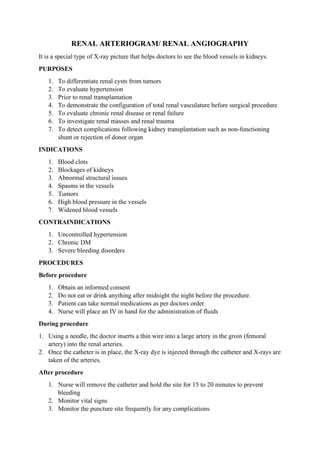RENAL ARTERIOGRAM.pdf
- 1. RENAL ARTERIOGRAM/ RENAL ANGIOGRAPHY It is a special type of X-ray picture that helps doctors to see the blood vessels in kidneys. PURPOSES 1. To differentiate renal cysts from tumors 2. To evaluate hypertension 3. Prior to renal transplantation 4. To demonstrate the configuration of total renal vasculature before surgical procedure 5. To evaluate chronic renal disease or renal failure 6. To investigate renal masses and renal trauma 7. To detect complications following kidney transplantation such as non-functioning shunt or rejection of donor organ INDICATIONS 1. Blood clots 2. Blockages of kidneys 3. Abnormal structural issues 4. Spasms in the vessels 5. Tumors 6. High blood pressure in the vessels 7. Widened blood vessels CONTRAINDICATIONS 1. Uncontrolled hypertension 2. Chronic DM 3. Severe bleeding disorders PROCEDURES Before procedure 1. Obtain an informed consent 2. Do not eat or drink anything after midnight the night before the procedure. 3. Patient can take normal medications as per doctors order 4. Nurse will place an IV in hand for the administration of fluids During procedure 1. Using a needle, the doctor inserts a thin wire into a large artery in the groin (femoral artery) into the renal arteries. 2. Once the catheter is in place, the X-ray dye is injected through the catheter and X-rays are taken of the arteries. After procedure 1. Nurse will remove the catheter and hold the site for 15 to 20 minutes to prevent bleeding 2. Monitor vital signs 3. Monitor the puncture site frequently for any complications
- 2. 4. Cold compression may be applied at the site of puncture COMPLICATIONS 1. Hematoma formation 2. Arterial thrombosis 3. False aneurysm formation 4. Temporary kidney failure

